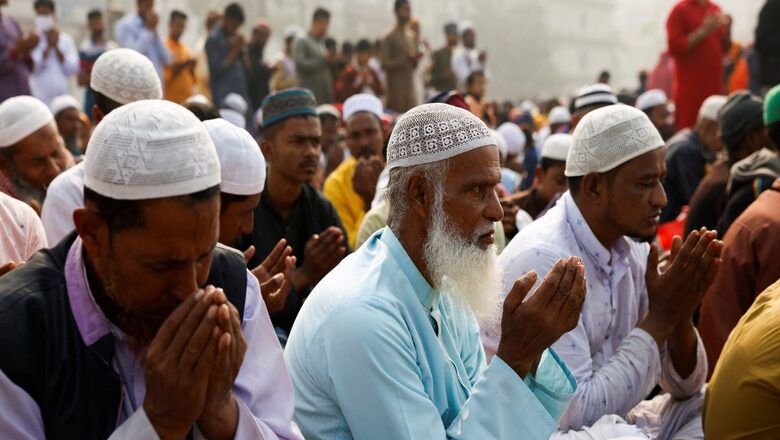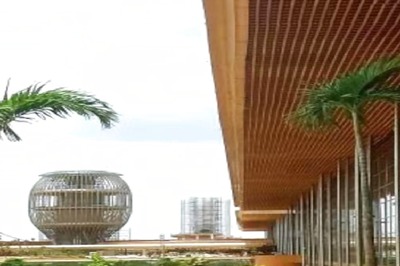
views
Indian Muslims constitute the largest segment of religious minority population in India. They are dispersed in 28 states and 8 union territories of the country as of 2023. The partition of the subcontinent in August 1947 left a substantial Muslim population in India. According to the 2011 Census of India, the Muslim population in India was around 172 million, which accounted for approximately 14.2 per cent of the country’s total population. It’s important to note that this is a decade-old figure. With around 204 million Muslims (2019 estimate), India’s Muslim population is about the world’s third largest after Indonesia and Pakistan and the world’s largest Muslim-minority population.
Under Articles 26, 27 and 28, minorities are free to manage their own religious affairs. The state cannot levy taxes for the promotion of any religion. Nor can there be compulsory attendance at religious worship or religious ceremonies in state-sponsored educational institutions. The state cannot discriminate against minority-managed institutions in the allocation of resources. Under Article 30, all minorities — religious, linguistic, or cultural — have the right to establish and administer educational institutions of their choice. Articles 345, 347, 350, 350A and 350 B, which relate to the rights of linguistic minorities are also relevant in this context.
For the most part, the Indian constitution provides the formal basis for full and equal participation of Muslims in the country’s public life and does not promote Hindu religion. The constitution provides a model for the protection of the rights and interests of religious, linguistic, and cultural minorities. However, each Indian Muslim group, because of the spatial and historical situation in which it is located, has a different set of problems and prospects to deal with. This means in India, there are many different groups of Muslims who live in different parts of the country and have different historical experiences. Because of this, each group of Indian Muslims faces unique challenges and opportunities that are specific to their situation.
So, when Left-leaning activists, liberal intelligentsia, conservative ulema, Muslim political leaders and foreign-funded agenda groups profess to speak for the 174 million Muslims of India, they need to be grilled as to which Muslims are they speaking on behalf of. Despite Islam’s claim of oneness, Muslims have their sects, creeds, castes, classes, and identities. India itself is home to linguistically and ethnically diverse Muslims, whose cultural practices can vary kilometre after kilometre, state by state or union territory.
For example, Islam’s great rift has been the Sunni and Shia split over the succession of the Prophet’s message. This created a sectarian divide that got bloodier and bloodier over the centuries and is still embroiled in violence, hatred, prejudice, and bias. Though geopolitical changes could eventually lead to convergence and cooperation between the two bitter rivals Saudi (Sunni) and Iran (Shia), the legacy of their rivalry has not seen much of sectarian violence in India, due to Bharat‘s civilisational ethos of acceptance and tolerance. Hence, even the Ahmadis find themselves safe and secure, able to practice their beliefs freely.
The same intelligentsia of Left-liberals who claim to speak for the 174 million Muslims goes strangely silent when it comes to the casteism practised by Muslims themselves, despite the claim of no caste discrimination in Islam. That the Pasmandas are 85 per cent of the Muslim population in India, is a fact, that even Sunni elites (Ashrafs) are discovering in the 21st century and that they did not have adult franchise in the 1946 elections, so couldn’t possibly have voted for the creation of Pakistan. The Muslim politics in India continue to be dominated by the elite Ashrafs who claim descent from the Prophet’s family and from Arabs.
Then there is the difference between the sects themselves among Muslims depending on which school of thought is followed. The Deobandis hate the Barelvis and the Barelvis cancel them out all the time. Islam itself has four schools of thought — Hanafi, Shafi, Maliki and Hanbali and the Shia Jafari, with the dominant Hanafi interpretations defining Sharia laws for us. The internet brought Zakir Naik types to the living rooms, so a lot of religious practices are influenced by individuals such as Javed Ghamidi and Asrar Ahmed of Pakistan, considered liberal and moderate, our own Maulana Wahiddudin Khan, previously an ideological follower of Maududi until his disillusionment brought him in from the Muslim far right. Now he is quoted every time the accusations are hurled about extremist views of Muslims as a defence shield.
Part of this huge diversity among Muslims is that the Quran is in Arabic, which isn’t the mother tongue of Indians and hence they must rely on the meanings through translations and interpretations by mullahs and preachers, who insert their own ideological bias into the sermons. This is why there is no consensus on the verses that are clearly anti-Semitic, advocate Islamic supremacy and Muslim exceptionalism as well as the dhimmitude (secondary status) of women. Now that mullahs have realised the internet has placed those translations and the original verses in the hands of the masses themselves, people are critically thinking and demanding answers from those who claim Islamic law is perfect and does not need any reform.
Also, a Muslim community living in a remote rural area may face different challenges than a Muslim community living in a big city with a diverse population. This means that to understand the issues and concerns of Indian Muslims, we need to consider the specific context and history of each group. For example, the Siddhi Yemenis who were acknowledged by the President of India in Rashtrapati Bhavan this year itself, have integrated into the Indian ethos since the time Arabs were trading in the Indian subcontinent in the 7th century. The same goes for the culturally different Bohras, be it the Suleymani, Dawoodi, Alia, Nagoshi or Jaafari. Some of their regressive practices such as FGM (female genital mutilation) have been brought to notice by their champion Dr Asgar Ali Engineer in the past, but they are as Indian as any other community and identify themselves as Indians first.
The Left-liberal intelligentsia never talks about the Labbay Muslims of Tamil Nadu or the Mappila Muslims of Kerala or the Meo Muslims of Rajasthan, except when they are in the news for rioting and there is a political blowup. One doesn’t expect them to even acknowledge the existence of atheist or agnostic Muslims who may run into lakhs but their narratives of struggling for freedom of expression don’t fit their narrative of oppression Olympics of the Indian Muslims that these “sole spokespersons” keep harping about in the foreign press, Jinnah style. Cultural Muslims are a sizeable population in India, and it is the lack of freethinking space that they are not able to come out of the closet.
India’s Muslim community is a tapestry woven with threads of diverse identities, cultures, beliefs, and histories. While the numbers might speak of a unified entity, the reality is far richer and more complex. In a land where linguistic, regional, and cultural variations flourish, Indian Muslims reflect the pluralism that defines the nation itself. The narrative of Indian Muslims cannot be confined to a single story, as it encompasses a multitude of experiences—rural and urban, conservative, and liberal, traditional and modern. The notion of a monolithic “Muslim voice” falls short of capturing the intricate nuances that define these communities.
The Indian constitution, with its provisions for minority rights, offers a framework for safeguarding their interests. As conversations unfold about their place in the country’s mosaic, acknowledging this kaleidoscope of perspectives is not just an act of accuracy but a celebration of the true essence of India’s multicultural tapestry.
The author is a writer and an educationist from Srinagar, Kashmir. Views expressed in the above piece are personal and solely that of the author. They do not necessarily reflect News18’s views.




















Comments
0 comment